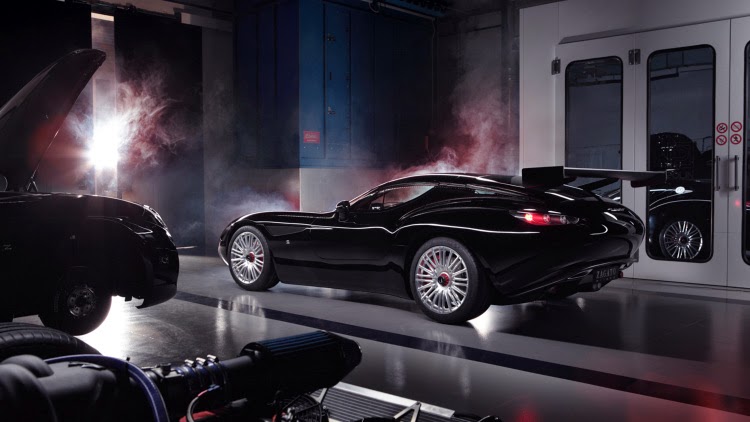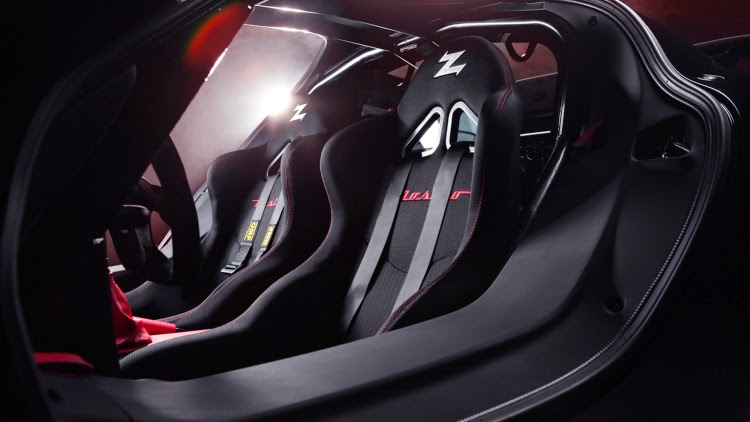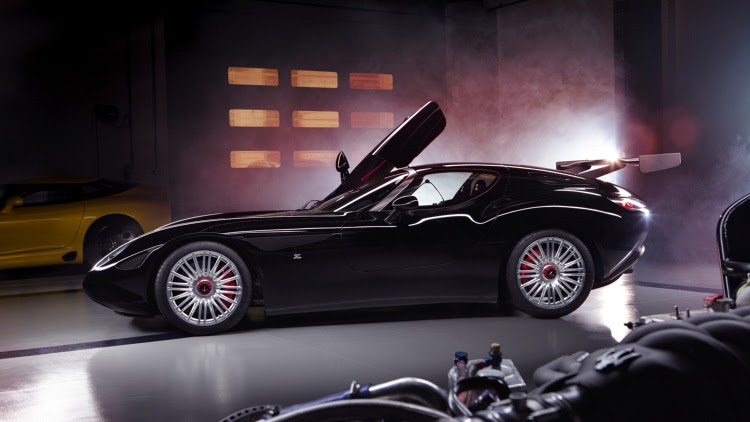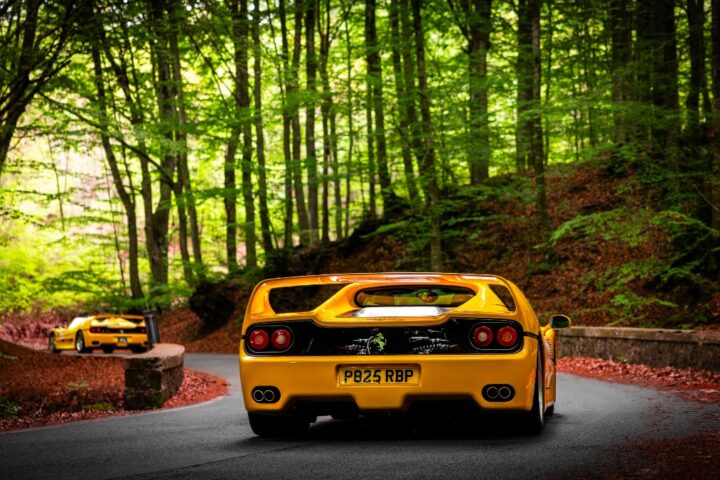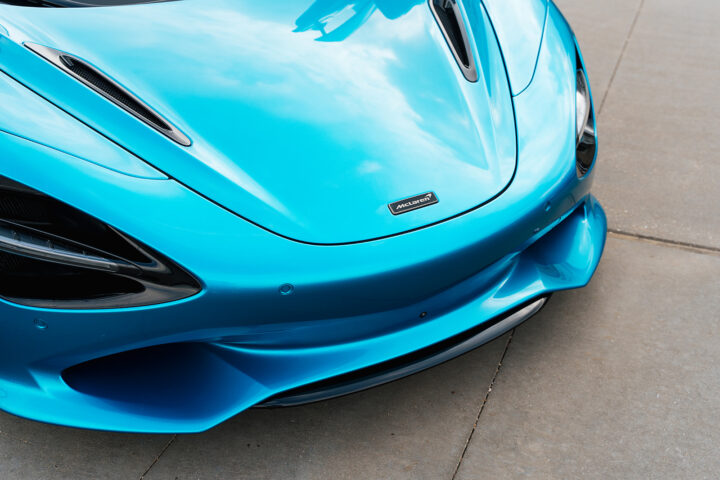The Mostro powered by Maserati is the latest creation of Zagato’s current Iconic decade, a new tradition for the atelier that began at the end of coachbuilder’s Neoclassical period (2000-2010) to celebrate the most iconic models of automotive history. Marking the delivery of the first customer car, Zagato will present the new Mostro as a world premiere at the Concorso d’Eleganza Villa d’Este.
Official Press Release:
ICONIC MODERN COLLECTIBLE CARS
In 2010, Andrea and Marella Zagato launched a project to celebrate 100 years of Alfa Romeo and it materialized into the Alfa Romeo TZ3 Corsa, a one-off, and then nine multiples of the TZ3 Stradale (road car) followed. Inspired by current trends in the automotive industry, these models initiated a new outflow of cars from the atelier, which has recognized some car models as icons on their own, at times bearing more importance than the marque itself. In the sector of collectible cars, this became the case for the Maserati “Monster” and “Birdcage”; Ferrari “GTO” and “Testarossa”; Alfa Romeo “8C” and “TZ”, and the Aston Martin “DB4 Zagato” and “Vanquish”. Among all of the mass-produced cars, this process also involved Fiat “500”; Volkswagen “Beetle” and “Golf”; Ford “Mustang” and GM “Corvette”; Porsche “911”; Dodge “Viper” and, perhaps also, for the Alfa Romeo “Giulia”.
The Mostro celebrates the centenary of Maserati and one of the most iconic racing cars in the history of the Tridente: the Maserati 450 S Coupé Zagato “Monster”, designed in 1957 with Frank Costin, a specialist in aerodynamics, and coachbuilt in Milan for the 24 Hours of Le Mans at the request of Stirling Moss.
Only five examples will be made and each has already been assigned to selected Zagato car collectors. Deliveries will be completed before December 2015, at the end of Maserati’s anniversary year.
REPRESENTING THE PUREST OF THE GRAN TURISMO CARS
Exactly as the Maserati 450 S Coupé Zagato “Monster” was built for sport competitions and, subsequently, converted into a road car, the Mostro has been created from pure racing mechanics while also being road sanctioned. This philosophy, stemming from the late ’40s, was the basis of the commercial success, both in sport and in style, for the Gran Turismo category. The cars from that period were produced with racing mechanics and also equipped with a luxurious interior that made them more comfortable for normal circulation. Zagato, since the ’20s, has been the leader in coachbuilding sport coupés and spiders with two-doors. During the second half of the ’50s, when the GT category had reached its height in popularity, the company founded in 1919 by Ugo Zagato was collaborating with all of the major European brands: Alfa Romeo, AC Cars, Aston Martin, Bristol, Ferrari, Fiat, Jaguar, Lancia, Maserati, OSCA, and Porsche.
FEATURES
The chassis of the Mostro is made of a MonoCell of carbon fiber coupled to a mid-structure of steel tubes in order to create the cockpit, as well as a subframe that sustains the fuel tank, exhaust system, rear suspension, and gearbox. Made in Italy, the bodywork is entirely carbon fiber.
The central-front, V8 Maserati engine with dry-sump lubrication is equipped with a customizable, engine-management system. The engine is connected to the rear-positioned gearbox (a semi-automatic, six-speed transmission) and differential by a rigid tube (transaxle), which optimally distributes the weight of the car along the longitudinal axis. The front and rear suspension have a double-wishbone architecture with a pushrod, spring/ shock absorber system. The Mostro is equipped with large disc brakes and 19″ alloy wheels. Front and rear tires specifications: 255/40 R19 and 295/35 R19.
#
Mostro powered by Maserati at the 2015 Concorso d’Eleganza Villa d’Este: Design
Cernobbio, May 2015. The Mostro, a coupé-body design on a sports car chassis, celebrates a rare icon of extreme performance belonging to an automotive era of great design and race engineering developments.
MASERATI 450 S ZAGATO “MONSTER”: A MONSTROUS SPORT COUPE’
The Maserati 450 S Coupé Zagato “Monster” was, until the ’90s, the most powerful front-engined race car in the world. At the 1957 24 Hours of Le Mans, amid a competition dominated by light, open-bodied barchettas, the 450 S Coupé Zagato was the only sports car with closed bodywork capable of competing for the final victory. Its futuristic shape (long nose, cockpit and round tail collectively designed to have a very compact volume) represented the most extreme and advanced concepts of aerodynamics at the time. Soon thereafter, Zagato started using the new aerodynamic concept of the truncated tail (or Coda Tronca) extensively, which had been introduced by Professor Wunibald Kamm.
The design of the 450 S Coupé Zagato “Monster”, traced by Frank Costin and Zagato, aimed to achieve maximum aerodynamic efficiency for the long straight of Hunaudières at Circuit de la Sarthe, where it could take off using all 400 hp of Maserati’s V8. Therefore, using Zagato’s Milanese school of thought, the body of the 450 S Coupé was designed and stylized accordingly, technically-projected by function before aesthetic. The result was harmonious in both style and technique, though artistically “raw”, and spontaneously executed by the carrozzeria’s fast drawings on blank sheets of white paper and hand-beaten aluminum sheets modeled into a body.
THE MOSTRO: AN ETERNAL FORM
In order to maintain the integrity of the original Monster, pure and essential in design and organically created by a combustion of creativity and fresh ideas, the Zagato Atelier designers precisely outlined their creative process for the new Mostro in advance. The goal was not to create a second “monster” body, but rather implement the same instinctive philosophy and approach towards volume that is at once simple and spontaneous. Thus, Zagato Atelier decided to avoid stylizing the Mostro and simply created a form.
The final design of the Mostro is not nostalgic, but rather iconic. Starting from the 450 S Coupé, there were specific design elements more substantial than others that identified its classic design and timeless beauty, then and now, in order to obtain the best aerodynamic result for a modern race car.
THE MOSTRO: A DYNAMIC SCULPTURE
The proportions of the Mostro are similar to those of the 450 S Coupé Zagato: an enormous frontal part that houses the engine, centrally positioned with exceptional vicinity to the driver for optimal weight distribution. This creates a sensation that there is no division between the interior of the body and its small, rounded tail.
The large front fender, running along the entire length of the frontal part, disappears at the door and from there begins the line of the car’s massive rear fender. These treatments of the car’s volume allow significant stylistic purity to remain with the shape of the bodywork.
The body of the Mostro presents a few additional design characteristics:
- Fixed glass windows along the sides (determining a broad freedom in creating the shape of the door)Wide windshield (to increase visibility while widening and lowering the interior)
- Doors opening with a high, forward movement (a functional choice, dictated by the shape of the carbon fiber cell)
- Large rear fixed-wing (produces adequate downforce on the rear axle).
###
Mostro powered by Maserati at the Concorso d’Eleganza Villa d’Este 2015: History
Cernobbio, May 2015. The Mostro was created as part of a long collaboration between the Milanese coachbuilder and the Tridente and was born on the grounds of competition. The partnership between Ugo Zagato and the Maserati brothers originated in the 1930s with the Tipo 26M Sport and was then immediately directed by a specific philosophy: to dress Maserati mechanics with sportier, lightweight and more aerodynamic bodies.
MASERATI TIPO 26M SPORT 1931
The first Maseratis produced by the factory, from 1926 with the 8-cylinder Type 26, were almost exclusively racing cars. In this context, the meeting with Zagato, at the time an official partner of Alfa Romeo and official supplier of Scuderia Ferrari, was a milestone in the history of Maserati. The first model with a Zagato body was the Type 26M, produced between 1930-’32, and was also known as the 8C 2500. The first chassis, n. 2520, left the factory in December 1931 and was sent to the Carrozzeria Zagato in Milan, selected in order to become a “Sport” version at the request of the customer, a well-known attorney of the Milan court. Zagato’s execution is evidence of the coachbuilder’s capacity to dress racing mechanics (the letter “M” corresponded to a single-seater cockpit despite its capacity for two passengers; though closed with a metal tonneau, one was for the mechanic/navigator) with the facade of a handsome, two-seater road car, for its intentioned use on the racetrack or even concours d’elegance.
MASERATI TIPO 4CS 1100 1933
In the early 1930s, of all the great sports cars with eight-cylinder engines, Maserati was studying a smaller model to also compete in the lower categories but, above all, to aspire to a prestigious class victory in the Mille Miglia. The new Maserati 4CTR (4-cylinder “Testa Riportata”), 4CM (4- cylinder, single-seater) and 4CS (4-cylinder sport) were mounting small, twin-cam engines with variable power from 90 to 115 hp. Appearing for the first time in prototype form at the Mille Miglia in ’31, this model went on to win its class the following year. During its production history, the first chassis to receive a Zagato body was n.1517 and was assembled in 1933. The tiny 1,100 cc motor with the now famous, lightweight Zagato body took part in various competitions, among them the 1936 Mille Miglia, where it finished tenth overall.
MASERATI V4 ZAGATO SPIDER 1934
The third Zagato Maserati model was born in 1934 and was another example of the typical functionalist perspective and approach in crafting Zagato bodies. It was a car born for racing that had the potential to combine technical sophistication with an elegant and balanced volume. The V4 was the first race car with a 16-cylinder engine in the history of motor racing. Developed as a single-seater for Grand Prix racing, the car debuted in Monza in 1929 with Alfieri Maserati. The V4 achieved the fastest average lap speed, freezing the record for 25 years. Two weeks following with the same car, Baconin Borzacchini, reached a new world record of 246 km/h during practice for the GP in Cremona.
Concluding its commitments to racing, the V4 remained with Maserati for some time until it was acquired by a client in Rome while he had been visiting the factory, who had asked for the car to be transformed for road use. Maserati entrusted Zagato with the realization of an elegant aluminum body that covered, without hiding, the car’s sophisticated and cutting-edge mechanics. Painted in a charming, two-tone green livery, the new, elegant and ethereal V4 became a frequent guest of salons in Rome. In ’34, the car won a major award at the Pincio Concorso d’Eleganza.
MASERATI A6 1500 COUPE’ PANORAMICA 1947
In 1919, Ugo Zagato founded his carrozzeria bringing his expertise in aviation to what, at the time, was a new automotive sector. In the ’20s, the lightweight, aircraft-inspired Zagato bodyworks imposed themselves leaders in competition. The innovative spirit of Zagato characterized the pioneering era of automobiles. Even during the Second World War, fleeing from the fury of conflict, Ugo Zagato continued his studies on aerodynamics. In the late ’40s, this focus created a new form called Panoramica, which was inspired by aircraft cockpits and influenced the innovative use of Plexiglas to model state-of-the-art glass surfaces for maximum visibility. The Maserati A6 1500 was one of the first examples of this new experimental body: a breakthrough design and revolutionary form in every component that was also united by an innate and elegant class. So unique, only the classic Maserati front grill permitted this car recognition as a model of the Tridente.
A6G/54 MASERATI COUPE’ 1954
With the end of the Second World War, Maserati began designing a chassis that could revive the brand, both in competition and on the road. This objective was entrusted to the A6 with a straight-6, 1500 cc engine, which Zagato also made into a Panoramica. The first evolution was introduced in 1950, the A6G, with an augmented two-liter engine and a range of two variations: the barchetta sport and GT coupé. In 1954, the climax in the development of the model arrived, the A6G/54, and it was designed with a new personality geared towards Gran Turismo racing. At the Turin Motor Show in 1954, Zagato introduced its own version, which was the most extreme and fascinating of all the proposals of the Italian car. Now considered one of the best examples of Italian Gran Turismo and a symbol of the era, the A6G/54 competed successfully within its category. The A6G/54 raced successfully during the same period of time and within the same category of racing as Elio Zagato, who was a leading promotor and influential figure of Gran Turismo.
Until 1957, approximately 60 examples of the A6G/54 had been built. Of these, 20 models were coachbuilt by Zagato, each one unique through personalized details.
MASERATI A6G/54 SPIDER 1955
At the 1955 Geneva Motor Show, Maserati introduced an important varation of the A6G/54 coupé and had entrusted the specialists at Zagato with this task. In complete contrast to the deliberately spartan and essential character of Zagato, the Milanese coachbuilder created a handsome spider body to dress the frame of n.2101. This variation underlined Zagato’s eclectic spirit, and demonstrated its consistent capability in appling functionalist and rationalist style to create an elegant form. The car was spotted by Juan Peron, then president of Argentina as well as husband of the legendary Evita. As a great motor enthusiast and admirer of Juan Manuel Fangio, the president agreed to purchase the car, though eventually was forced to cancel his purchase because of a political crisis in Argentina. Used for promotional events, the A6G/54 Spider was eventually purchased by an American in 1958.
MASERATI 450 S COUPE’ ZAGATO “MONSTER” 1957
The Maserati 450 S, built for the 1957 World Sportscar Championship, represented the highest point of Maserati’s official dedication to competition. In the midst of the exciting season in which the brand fought to the end for their victory, the 24 Hours of Le Mans represented, along with the Mille Miglia, a kind of moral triumph for the whole Championship. Maserati commissioned Zagato to build a coupé body for chassis n.4501. This decision was the result of the pressing demands of Stirling Moss. Likely, it was also he who asked Frank Costin, an expert in aerodynamics, to collaborate with Zagato on the model.
Zagato, working while instructed by the English technician, built a lightweight, aluminum body in record time, obtaining an extraordinary result in terms of weight. With respect to the barchetta, the coupé weighed only 65 kg more. That special form was created, through rigorous design decisions based on functionality, and the power of an 8-cylinder, 4.5 liter, 400 hp engine, contributed to the car’s eloquent nickname: the “Monster.”
Moss, who was paired with Harry Schell at Le Mans, became the protagonist of an extraordinary battle against Ferrari and Jaguar. The 450 S Coupé Zagato, despite starting from second position, managed to take the lead within a few laps, thanks to its favorable characteristics: a very low weight and an incredibile capacity for speed of 320 km/h. The car remained in command until the beginning of the night when only an engine failure interrupted the extraordinary showdown. Though returned to the factory, it was bought by an American named Byron Staver the following year and turned into a road car. He decided to repaint it from rosso corsa, typical of Italian cars, to a more elegant and minimalist black.
MASERATI 3500 GTZ 1959
For Maserati, the year 1957 was a year of radical change. At the end of the World Manufacturer’s Championship, the company declared that it would not renew the commitment for the following year (though it would continue to support private customers and the development of new racing cars). On the production side of the road models, the revolution had already begun in the previous months. At the Geneva Motor Show in March, Maserati debuted the 3500 GT, a coupé more comfort-oriented, luxurious and better finished. A sketch of a Zagato version was presented as part of the manufacturer’s stand and it had also been included in the official catalog that year for the range. The 3500 GTZ, traditionally sportier than other variations, was strongly in line with the origins of the Maserati brand. Those times, however, were long gone as the Orsi family had already started building Maserati from sport to sports luxury, which today has made it one of the most respected brands in the world.
The 3500 GTZ’s simple and pure sports body was later chosen in 1959 to dress the chassis of an A6G/54 (n.2155) after an accident.
THE 60S: ZAGATO AND THE MASERATI BROTHERS FOR OSCA
In 1948, the Maserati brothers surrendered their stake in the business to the Orsi family (having entered as shareholders in 1937 when Orsi bought the company) and founded a new company for themselves called Officina Specializzata Costruzioni Automobili (OSCA). Zagato maintained a strong relationship with the Maserati brothers based on their common philosophies oriented towards racing cars, and so collaborations continued with OSCA. In 1951, the Milanese coachbuilder made a coupé body for the third of a triptych of competition chassis (the first two made as single-seaters) that was equipped with a 12-cylinder, 4.5 liter engine. In 1960, the small Bologna-based company, having grown in fame and authority in the category of sports cars, commissioned Zagato to make a limited-series of a GT coupé. The first model traced by Ercole Spada, the Osca 1600 GT Zagato became one of sportiest, most fascinating of its era, fast on the road and competitive in racing.
MASERATI BITURBO SPYDER 1984
In the late 50s, the activities of Carrozzeria Zagato reached a semi-industrial size. The official collaboration with renowned sports brands of the period pushed the company to move, in 1961, from Milan to a larger production site in Arese, near to where the future headquarters of Alfa Romeo would be built. In this plant, the company began its production of fuoriserie road and racing cars at ever-increasing rates to meet industry demand.
In 1984, the collaboration with Maserati resumed at full speed. Alejandro De Tomaso, enchanted by the one-off A6G/54 Spider, awarded Elio and Gianni Zagato the task of creating the design and production of the Biturbo Spyder.
Distinguished by a shorter wheelbase of 11 centimeters, compared to the “closed” version (that was adjusted in order to strengthen the chassis and harmonize it with the body), the Birturbo Spyder retained the same six-cylinder, two-liter, twin-turbo engine. Stylistically, it was characterized by a fabric roof that, once lowered, disappeared into a special compartment created by the new design of the rear. In 1989, the model evolved with a new version equipped with a more powerful, 2.8-liter engine. In the same period, the commercial push also launched in the American market, where it was sold with a 2.5-liter engine and catalytic converter. In total, production reached nearly 7,000 units.
MASERATI KARIF 1988
One of the most distinctive features of the 80’s was the phenomenon of an ‘Instant Classic’ automobile. A few current production cars were included in this exclusive club of prestige models and were identified immediately as collectibles. Zagato, consistent since the beginning under the philosophy outlined by the founder (two-door, two-seater sports cars, bodied as coupés or spiders) lended great impetus to the Instant Classic niche with various designs in limited series.
In 1988, along with the Biturbo Spyder, Maserati entrusted Zagato with the job of creating of a special version. The Karif was a coupé developed on the chassis of the Spyder, though shorter and stronger than the Biturbo, and was distinguished by its small, fixed hard-top. This two-door, slim lightweight, capable of 280 hp (225 hp on U.S. model) was produced in just over 200 units. In the same period, Zagato was assembling the four-seater, coupé version for Maserati named 228.
MASERATI GS ZAGATO 2007
In 2007, at the request of Maserati’s CEO Karl-Heinz Kalbfell, Zagato prepared a V-Max Concept (prototype prepared and capable of reaching its maximum speed) as a preview of an imminent, limited series. The Maserati GS Zagato, which had been presented at the Concorso d’Eleganza Villa d’Este, celebrated the A6G/54 Coupé Zagato. To create this model, the Milanese atelier had chosen the mechanics of the Spyder 4.2 with a shorter wheelbase of 180 mm, with respect to the coupé, in the same way that had been done for the Karif. Born in the Neoclassic automotive era, which was developed by Zagato in the first decade of the New Millennium, the GS Zagato was designed through virtual reality modeling and handmade with sheets of aluminum on a master model (on a scale of 1:1). This is the approach of a modern atelier, using the latest design technology and expert craftmanship for the process of construction. The change in Maserati’s management prevented the production of this model, which would have married the performance of Ferrari’s eight cylinders to a lightweight, short-wheelbase and compact body in the best tradition of the two brands.

